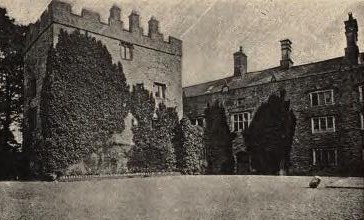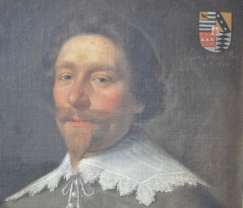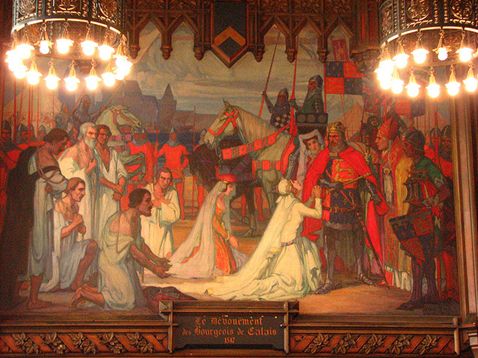|
Philip Stapleton
Sir Philip Stapleton of Wighill and of Warter-on-the-Wolds, Yorkshire (1603 – 18 August 1647) was an English Member of Parliament, a supporter of the Parliamentary cause during the English Civil War, and a colonel in the Parliamentary Army until 1645. His surname is also sometimes spelt Stapylton or Stapilton. Life Born in 1603 at Warter-on-the-Wolds, Yorkshire, he was the second son of Sir Henry Stapleton of Wighill (Wighill, Yorkshire, 1572 – St. Andrews, 16 February 1630/1631) and wife Mary Forster ( Bamborough Castle, Northumberland, 30 March 1569 – St. Andrew Holborn Parish, London, Middlesex, 6 November 1656).Foster, Joseph. ''Pedigrees of the county families of Yorkshire'', Vol. 2, p. 189. London: The Compiler, 187p. 189/ref>Dugdale, William. ''Dugdale's Visitation of Yorkshire, with additions.'' Vol. 2, pp. 174-175. "Stapleton of Watrep. 174./ref> He was admitted as a fellow commoner of Queens' College, Cambridge in 1617. On 25 May 1630, he was knighted by King Ch ... [...More Info...] [...Related Items...] OR: [Wikipedia] [Google] [Baidu] |
Wighill
Wighill is a village and civil parish in the county of North Yorkshire, England. It is near the River Wharfe and east of Wetherby, West Yorkshire. The village has one public house, the White Swan Inn, which reopened in 2009 after a two-year closure. Uhtred the Bold was murdered here in 1016. History In 1016, Uhtred was slain at a place called ''Wicheal'' by Cnut and a band of several men who had lain in wait for Uhtred. Several people have suggested that Wicheal is wighill. The village is mentioned in the Domesday Book as belonging to Geoffrey Alselin, and having 18 villagers and nine ploughlands. The name of the village is recorded as deriving from the Old English ''wic-halh'', a ''nook of land with a dairy farm''. The south end of the parish borders a meander of the River Wharfe. The old township was sometimes referred to as ''Wighill-cum-Esedyke'', a reference to a place called Easdyke just west of the village, which had a drain into the river. One of the descendants of th ... [...More Info...] [...Related Items...] OR: [Wikipedia] [Google] [Baidu] |
English Committee Of Safety
The Committee of Safety, established by the Parliamentarians in July 1642, was the first of a number of successive committees set up to oversee the English Civil War against King Charles I, and the Interregnum. 1642–1644 The initial committee of safety consisted of five members of the House of Lords: the Earls of Essex, Holland, Northumberland and Pembroke and Viscount Saye-and-Sele, and ten members of the House of Commons: Nathaniel Fiennes, John Glynn, John Hampden, Denzil Holles, Henry Marten, Sir John Merrick, William Pierrepoint, John Pym, Sir Philip Stapleton, and Sir William Waller. It sat until 1644 when Parliament and their new Scottish allies agreed to replace it with the Committee of Both Kingdoms.Robert PlantThe Committee of Safety Retrieved 2009-11-25 1647 The Presbyterians in the House of Commons set up a new committee of safety, to coordinate defence of London and Parliament from the New Model Army which was advancing on London with demands that the Pr ... [...More Info...] [...Related Items...] OR: [Wikipedia] [Google] [Baidu] |
Roman Catholic
The Catholic Church (), also known as the Roman Catholic Church, is the largest Christian church, with 1.27 to 1.41 billion baptized Catholics worldwide as of 2025. It is among the world's oldest and largest international institutions and has played a prominent role in the history and development of Western civilization. O'Collins, p. v (preface). The church consists of 24 ''sui iuris'' (autonomous) churches, including the Latin Church and 23 Eastern Catholic Churches, which comprise almost 3,500 dioceses and eparchies around the world, each overseen by one or more bishops. The pope, who is the bishop of Rome, is the chief pastor of the church. The core beliefs of Catholicism are found in the Nicene Creed. The Catholic Church teaches that it is the one, holy, catholic and apostolic church founded by Jesus Christ in his Great Commission, that its bishops are the successors of Christ's apostles, and that the pope is the successor of Saint Peter, upo ... [...More Info...] [...Related Items...] OR: [Wikipedia] [Google] [Baidu] |
Thomas FitzWilliam, 4th Viscount FitzWilliam
Thomas FitzWilliam, 4th Viscount FitzWilliam (c.1640–1704) was an Irish nobleman and statesman; he was a leading Irish Jacobite, and a political figure of some importance during the Williamite War in Ireland. Background He was the only son of William FitzWilliam, 3rd Viscount FitzWilliam and Mary Luttrell, daughter of Thomas Luttrell of Luttrellstown Castle. He was probably born at Dundrum Castle, where his parents lived in the early 1640s. After the Irish Rebellion of 1641 the FitzWilliams, who had previously been among the largest landowners in Dublin, were dispossessed of most of their lands. Thomas's father spent some years in France and fought for Charles I in England during the English Civil War, becoming Governor of Whitchurch. In 1655 William and his elder brother Oliver FitzWilliam, 1st Earl of Tyrconnell, having made their peace with the English Parliament, were allowed to recover part of the family estate. After the Restoration of Charles II the FitzWilliams, ... [...More Info...] [...Related Items...] OR: [Wikipedia] [Google] [Baidu] |
Henry Fairfax, 4th Lord Fairfax Of Cameron
Henry Fairfax, 4th Lord Fairfax of Cameron (30 December 1631 – 13 April 1688) was an English politician. He was the grandson of Thomas Fairfax, 1st Lord Fairfax of Cameron. He was born the son of Henry Fairfax, of York, Rector of Bolton Percy, Yorkshire and Lady Mary Cholmondeley (1593-1649) and educated at Gray's Inn. He took part in the Yorkshire rising in support of George Monck in January 1660 under the leadership of his cousin Thomas Fairfax, 3rd Lord Fairfax. He later succeeded his cousin in 1671, inheriting the family estate at Denton, North Yorkshire. He sat in Parliament to represent Yorkshire in March and October 1679 and again in 1681. He married Frances Barwick, and they had ten children: * Mary Fairfax (born 29 July 1653) * Dorothy Fairfax (born 30 December 1655) * Thomas Fairfax, 5th Lord Fairfax of Cameron (born 1657) * Henry Fairfax Of Toulston (born 20 April 1659) * Ursula Fairfax (born 3 May 1661) * Frances Fairfax (born 2 April 1663) * Bryan Fairfa ... [...More Info...] [...Related Items...] OR: [Wikipedia] [Google] [Baidu] |
Sir Wilfrid Lawson, 1st Baronet, Of Isell
Sir Wilfrid Lawson, 1st Baronet, of Isel Hall, Cumberland (c. 1610–1688) was an English landowner and politician who sat in the House of Commons from 1660 to 1679. Life Lawson was born in 1610, the son of William Lawson, and his wife Judith Bewley, daughter of William Bewley of Hesket. His great uncle was Sir Wilfred Lawson who acquired the family estate of Isel in Elizabethan times and served as MP for Cumberland. Lawson matriculated at Queen's College, Oxford on 21 November 1628, aged 17. He was knighted by Charles I on 28 February 1641. Although knighted by Charles I in 1641, and appointed to the position of ship money sheriff and a nominee to the commission of array, Lawson became active on parliaments behalf at the start of the English Civil War. He set up a garrison on St Herbert's Island, Derwent Water, then part of his estate, and became commander-in-chief for Cumberland in 1644. He held local office throughout the Interregnum, and sat for the county in Richar ... [...More Info...] [...Related Items...] OR: [Wikipedia] [Google] [Baidu] |
Cumberland
Cumberland ( ) is an area of North West England which was historically a county. The county was bordered by Northumberland to the north-east, County Durham to the east, Westmorland to the south-east, Lancashire to the south, and the Scottish counties of Dumfriesshire and Roxburghshire to the north. The area includes the city of Carlisle, part of the Lake District and North Pennines, and the Solway Firth coastline. Cumberland had an administrative function from the 12th century until 1974, when it was subsumed into Cumbria with Westmorland as well as parts of Yorkshire and Lancashire. It gives its name to the unitary authority area of Cumberland, which has similar boundaries but excludes Penrith. Early history In the Early Middle Ages, Cumbria was part of the Kingdom of Strathclyde in the Hen Ogledd, or "Old North", and its people spoke a Brittonic language now called Cumbric. The first record of the term 'Cumberland' appears in AD 945, when the ''Anglo-Saxon Chronic ... [...More Info...] [...Related Items...] OR: [Wikipedia] [Google] [Baidu] |
East Riding Of Yorkshire
The East Riding of Yorkshire, often abbreviated to the East Riding or East Yorkshire, is a Ceremonial counties of England, ceremonial county in the Yorkshire and the Humber region of England. It borders North Yorkshire to the north and west, South Yorkshire to the south-west, and Lincolnshire to the south across the Humber Estuary. The city of Kingston upon Hull is the largest settlement. The county has an area of and a population of 600,259. Kingston upon Hull is by far the largest settlement, with population of 267,014, and is a major port and the county's economic and transport centre. The rest of the county is largely rural, and the next largest towns are the seaside resort of Bridlington (35,369) and the historic town of Beverley (30,351), which is also the county town. The county is governed by two unitary authorities, East Riding of Yorkshire Council and Hull City Council. It takes its name from the East Riding County Council, East Riding, a historic subdivision of York ... [...More Info...] [...Related Items...] OR: [Wikipedia] [Google] [Baidu] |
York
York is a cathedral city in North Yorkshire, England, with Roman Britain, Roman origins, sited at the confluence of the rivers River Ouse, Yorkshire, Ouse and River Foss, Foss. It has many historic buildings and other structures, such as a York Minster, minster, York Castle, castle and York city walls, city walls, all of which are Listed building, Grade I listed. It is the largest settlement and the administrative centre of the wider City of York district. It is located north-east of Leeds, south of Newcastle upon Tyne and north of London. York's built-up area had a recorded population of 141,685 at the 2021 United Kingdom census, 2021 census. The city was founded under the name of Eboracum in AD 71. It then became the capital of Britannia Inferior, a province of the Roman Empire, and was later the capital of the kingdoms of Deira, Northumbria and Jórvík, Scandinavian York. In the England in the Middle Ages, Middle Ages it became the Province of York, northern England ... [...More Info...] [...Related Items...] OR: [Wikipedia] [Google] [Baidu] |
Sir John Hotham, 1st Baronet
Sir John Hotham, 1st Baronet ( – 3 January 1645) of Scorborough Hall, near Driffield, Yorkshire, was an English Member of Parliament who was Governor of Hull in 1642 shortly before the start of the Civil War. He refused to allow King Charles I or any member of his entourage to enter the town, thereby depriving the king of access to the large arsenal contained within. Later in the Civil War he and his son John Hotham the younger were accused of treachery to the Parliamentarian cause, found guilty and executed on Tower Hill. Origins He was born in 1589 the second but only surviving son of John Hotham (1540–1609) of Scorborough, who in 1584 had been elected a Member of Parliament for Scarborough in Yorkshire. His mother has been variously given as Julian Stanhope, a daughter of Sir Michael Stanhope of Shelford, Nottinghamshire or as Jane Legard, a daughter of Richard Legard of Rysome, Yorkshire. Career He fought on the continent of Europe during the early part of t ... [...More Info...] [...Related Items...] OR: [Wikipedia] [Google] [Baidu] |
Calais
Calais ( , , traditionally , ) is a French port city in the Pas-de-Calais department, of which it is a subprefecture. Calais is the largest city in Pas-de-Calais. The population of the city proper is 67,544; that of the urban area is 144,625 (2020). and it is reflected in the city's name in the local Picard language, ''Calés''. Other archaic names for the city are Portuguese ''Calêsio'' and German ''Kalen''. ''Kales'', the city's historic name in Dutch and West Flemish (once spoken in the area) was retained until more recently in the name for the Strait of Dover, ''Nauw van Kales'', and is still used in Dutch sources wishing to emphasise former linguistic ties to the area. Though the modern French spelling of ''Calais'' gradually supplanted other variants in English, the pronunciation () persisted and survives in other towns named for the European city including Calais, Maine, and Calais, Vermont, in the United States. In " De Gustibus" (1855), Robert Browning r ... [...More Info...] [...Related Items...] OR: [Wikipedia] [Google] [Baidu] |



